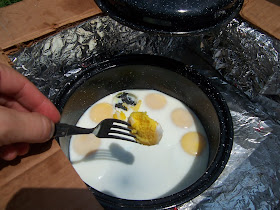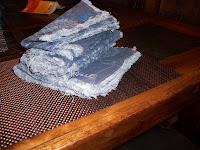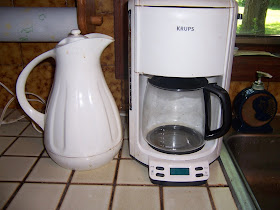In my last post, I described how every electric appliance has a little tag that tells you how many watts it uses. Let's convert those watts into money.
My electric bill tells me that I pay 8.774 cents per kWh, plus a bunch of taxes and other fees. That sentence has two confusing things---nasty decimals, and a horrid abbreviation---so let's translate that into something that makes sense to us. A "kWh" (or kiloWatt-hour) means 1000 watt-hours -- the same as one hour of ten 100-watt lightbulbs. Lightbulbs are easier to think about than kWh's: the electric bill is really saying it costs 8.774 cents (plus taxes and fees) to run ten bright lightbulb for one hour.
The decimal 8.774 (plus other fees) is ugly and hard to pin down. Let's round it off, and say I pay between 10 and 20 cents. (Energy prices go up and down, and I don't really turn a lightbulb off after exactly one hour, so rounding is okay. This is definitely a case where I don't want to let the perfect be the enemy of the good.) My bill tells me that I spend about 10 or 20 cents to run ten lightbulbs, or about 1 or 2 penny per lightbulb.
 |
| A 100-watt lightbulb costs me somewhere between 1 and 2 cents per hour. |
I live in Pennsylvania; your rates might be different. My sister lives in California where the base electric rates are about 15 cents per kWh, so she would pay more than 2 cents to run the same lightbulb. (Except she got solar panels, so she pays nothing . . . but that's a different story).
If I still used incandescent lightbulbs (
shudder), and I leave one of them on for about 10 hours a day (say, I turn it on in the morning and forget to turn it off before I go to work, or I leave on a porch light all night), that's 10-20 cents a day for that one lightbulb, or somewhere between $36.50 and $73 per year. Switching to a flourescent (23W) is about a quarter that cost, bringing the yearly cost of that bulb down to save at least $27 a year. Maybe that doesn't sound like a big difference . . . but how many lightbulbs are on in your house right now? My current count: 2 on in my kid's bedroom, 3 in the hallways, 4 in the kitchen, 1 in the dining room, and 3 in my bedroom.
Using a lightbulb comparison can help decide whether other energy-saving efforts are worth it. For example, should I use scissors instead of an electric razor to cut my family's hair?

Scissors use 0 watts per hour. My razor uses 10 watts, which is one-tenth of a lightbulb. That means, if I run the razor for a whole hour, I use less than 2/10th of a penny; if I cut my husband's hair in only 7 minutes that costs . . . well . . . it costs so little that it's not worth computing. And considering that if I used scissors he'd look like Frankenstein with a mohawk, I'm going to stick with the electric razor.
Here's another example. My coffee-maker brews a pot in exactly ten minutes. [Funny aside here: I know it takes this long because I wake up at 5:50, hit the snooze alarm, turn on the coffee, and go back to bed. The coffee and the second alarm beep at almost exactly the same time. My husband gets the coffee maker ready to go the night before -- we say that the reason he has that job is that we're Christians, and it says right there in the Bible, "He brews."]
Sorry, back to electricity. Once the coffee brews, I pour myself a cup and then put the rest of the coffee in a thermos. When my son broke the thermos, did it make sense to shell out money for a new one?
My husband won't drink coffee after it's one hour old, so we'd leave the pot on for an hour if we had no thermos. (I'll drink old, lukewarm coffee, of course). A thermos uses 0 watts. The coffee pot uses 1100 watts, which is eleven lightbulbs, or more than 11 cents. Eleven cents a day is more than ten cents a day, which is $36 per year . . . so yes, it makes sense to buy another thermos if we can get it for less than $36.













































